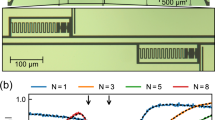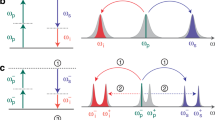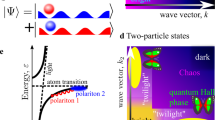Abstract
Superconducting qubits in a waveguide have long-range interactions mediated by photons that cause the emergence of collective states. Destructive interference between the qubits decouples the collective dark states from the waveguide environment. Their inability to emit photons into the waveguide render dark states a valuable resource for preparing long-lived quantum many-body states and realizing quantum information protocols in open quantum systems. However, they also decouple from fields that drive the waveguide, making manipulation a challenge. Here we show the coherent control of a collective dark state that is realized by controlling the interactions between four superconducting transmon qubits and local drives. The dark state’s protection against decoherence results in decay times that exceed those of the waveguide-limited single qubits by more than two orders of magnitude. Moreover, we perform a phase-sensitive spectroscopy of the two-excitation manifold and reveal bosonic many-body statistics in the transmon array. Our dark-state qubit provides a starting point for implementing quantum information protocols with collective states.
This is a preview of subscription content, access via your institution
Access options
Access Nature and 54 other Nature Portfolio journals
Get Nature+, our best-value online-access subscription
$29.99 / 30 days
cancel any time
Subscribe to this journal
Receive 12 print issues and online access
$209.00 per year
only $17.42 per issue
Buy this article
- Purchase on Springer Link
- Instant access to full article PDF
Prices may be subject to local taxes which are calculated during checkout




Similar content being viewed by others
Data availability
The data that support the findings of this study are available on Zenodo (https://zenodo.org/record/5772190).
Code availability
The code used for data analysis and simulated results is available from the corresponding author upon reasonable request.
References
Sheremet, A. S., Petrov, M. I., Iorsh, I. V., Poshakinskiy, A. V. & Poddubny, A. N. Waveguide quantum electrodynamics: collective radiance and photon-photon correlations. Preprint at https://arxiv.org/abs/2103.06824 (2021).
Roy, D., Wilson, C. M. & Firstenberg, O. Colloquium: strongly interacting photons in one-dimensional continuum. Rev. Mod. Phys. 89, 021001 (2017).
Masson, S. J. & Asenjo-Garcia, A. Atomic-waveguide quantum electrodynamics. Phys. Rev. Research 2, 043213 (2020).
Goban, A. et al. Atom–light interactions in photonic crystals. Nat. Commun. 5, 3808 (2014).
Corzo, N. V. et al. Large Bragg reflection from one-dimensional chains of trapped atoms near a nanoscale waveguide. Phys. Rev. Lett. 117, 133603 (2016).
Lodahl, P., Mahmoodian, S. & Stobbe, S. Interfacing single photons and single quantum dots with photonic nanostructures. Rev. Mod. Phys. 87, 347 (2015).
Astafiev, O. et al. Resonance fluorescence of a single artificial atom. Science 327, 840–843 (2010).
Forn-Díaz, P. et al. Ultrastrong coupling of a single artificial atom to an electromagnetic continuum in the nonperturbative regime. Nat. Phys. 13, 39–43 (2017).
Hoi, I.-C. et al. Generation of nonclassical microwave states using an artificial atom in 1D open space. Phys. Rev. Lett. 108, 263601 (2012).
Kannan, B. et al. Generating spatially entangled itinerant photons with waveguide quantum electrodynamics. Sci. Adv. 6, eabb8780 (2020).
Sundaresan, N. M., Lundgren, R., Zhu, G., Gorshkov, A. V. & Houck, A. A. Interacting qubit-photon bound states with superconducting circuits. Phys. Rev. X 9, 011021 (2019).
Kim, E. et al. Quantum electrodynamics in a topological waveguide. Phys. Rev. X 11, 011015 (2021).
van Loo, A. F. et al. Photon-mediated interactions between distant artificial atoms. Science 342, 1494–1496 (2013).
Mirhosseini, M. et al. Cavity quantum electrodynamics with atom-like mirrors. Nature 569, 692–697 (2019).
Lalumière, K. et al. Input-output theory for waveguide QED with an ensemble of inhomogeneous atoms. Phys. Rev. A 88, 043806 (2013).
Goban, A. et al. Superradiance for atoms trapped along a photonic crystal waveguide. Phys. Rev. Lett. 115, 063601 (2015).
Kim, J.-H., Aghaeimeibodi, S., Richardson, C. J. K., Leavitt, R. P. & Waks, E. Super-radiant emission from quantum dots in a nanophotonic waveguide. Nano Lett. 18, 4734–4740 (2018).
Mlynek, J. A., Abdumalikov, A. A., Eichler, C. & Wallraff, A. Observation of Dicke superradiance for two artificial atoms in a cavity with high decay rate. Nat. Commun. 5, 5186 (2014).
Rosario Hamann, A. et al. Nonreciprocity realized with quantum nonlinearity. Phys. Rev. Lett. 121, 123601 (2018).
Brehm, J. D. et al. Waveguide bandgap engineering with an array of superconducting qubits. npj Quantum Mater. 6, 10 (2021).
González-Tudela, A., Paulisch, V., Chang, D. E., Kimble, H. J. & Cirac, J. I. Deterministic generation of arbitrary photonic states assisted by dissipation. Phys. Rev. Lett. 115, 163603 (2015).
Albrecht, A., Henriet, L., Asenjo-Garcia, A., Dieterle, P. B., Painter, O. & Chang, D. E. Subradiant states of quantum bits coupled to a one-dimensional waveguide. New J. Phys. 21, 025003 (2019).
Orell, T., Michailidis, A. A., Serbyn, M. & Silveri, M. Probing the many-body localization phase transition with superconducting circuits. Phys. Rev. B 100, 134504 (2019).
Fayard, N., Henriet, L., Asenjo-Garcia, A. & Chang, D. E. Many-body localization in waveguide quantum electrodynamics. Phys. Rev. Research 3, 033233 (2021).
Paulisch, V., Kimble, H. J. & González-Tudela, A. Universal quantum computation in waveguide QED using decoherence free subspaces. New J. Phys. 18, 043041 (2016).
Hacohen-Gourgy, S., Ramasesh, V. V., De Grandi, C., Siddiqi, I. & Girvin, S. M. Cooling and autonomous feedback in a Bose-Hubbard chain with attractive interactions. Phys. Rev. Lett. 115, 240501 (2015).
Lu, Y. et al. Characterizing decoherence rates of a superconducting qubit by direct microwave scattering. npj Quantum Inf. 7, 35 (2021).
Burnett, J. J. et al. Decoherence benchmarking of superconducting qubits. npj Quantum Inf. 5, 54 (2019).
Müller, C., Lisenfeld, J., Shnirman, A. & Poletto, S. Interacting two-level defects as sources of fluctuating high-frequency noise in superconducting circuits. Phys. Rev. B 92, 035442 (2015).
Koch, J. et al. Charge-insensitive qubit design derived from the Cooper pair box. Phys. Rev. A 76, 042319 (2007).
Pozar, D. M. Microwave Engineering 4th edn (Wiley, 2012).
Dalmonte, M. et al. Realizing dipolar spin models with arrays of superconducting qubits. Phys. Rev. B 92, 174507 (2015).
Probst, S., Song, F. B., Bushev, P. A., Ustinov, A. V. & Weides, M. Efficient and robust analysis of complex scattering data under noise in microwave resonators. Rev. Sci. Instrum. 86, 024706 (2015).
Leek, P. J. et al. Cavity quantum electrodynamics with separate photon storage and qubit readout modes. Phys. Rev. Lett. 104, 100504 (2010).
Leibfried, D., Blatt, R., Monroe, C. & Wineland, D. Quantum dynamics of single trapped ions. Rev. Mod. Phys. 75, 281 (2003).
Roushan, P. et al. Spectroscopic signatures of localization with interacting photons in superconducting qubits. Science 358, 1175–1179 (2017).
Ma, R., Saxberg, B., Owens, C., Leung, N., Lu, Y., Simon, J. & Schuster, D. I. A dissipatively stabilized Mott insulator of photons. Nature 566, 51–57 (2019).
Orell, T. et al. Collective bosonic effects in an array of transmon devices. Preprint at https://arxiv.org/abs/2112.08134 (2021).
Reiter, F. & Sørensen, A. S. Effective operator formalism for open quantum systems. Phys. Rev. A 85, 032111 (2012).
Besse, J.-C. et al. Realizing a deterministic source of multipartite-entangled photonic qubits. Nat. Commun. 11, 4877 (2020).
Ke, Y., Poshakinskiy, A. V., Lee, C., Kivshar, Y. S. & Poddubny, A. N. Inelastic scattering of photon pairs in qubit arrays with subradiant states. Phys. Rev. Lett. 123, 253601 (2019).
Scigliuzzo, M. et al. Primary thermometry of propagating microwaves in the quantum regime. Phys. Rev. X 10, 041054 (2020).
Hoi, I.-C. et al. Demonstration of a single-photon router in the microwave regime. Phys. Rev. Lett. 107, 073601 (2011).
Brody, D. C. Biorthogonal quantum mechanics. J. Phys. A: Math. Theor. 47, 035305 (2013).
Autler, S. H. & Townes, C. H. Stark effect in rapidly varying fields. Phys. Rev. 100, 703 (1955).
Barnett, S. and Radmore, P. M. Methods in Theoretical Quantum Optics (Oxford Univ. Press, 2002).
Acknowledgements
We thank A. Strasser for fabricating the waveguide sample. We would like to thank E. I. Rosenthal for valuable comments on the manuscript. M.Z. and S.O. acknowledge funding by the European Research Council (ERC) under the European Union’s Horizon 2020 research and innovation programme (714235). M.Z. and C.M.F.S. acknowledge support by the Austrian Science Fund FWF within the DK-ALM (W1259-N27). R.A. acknowledges support from the Austrian Science Fund FWF within the SFB-BeyondC (F7106-N38). T.O. and M.S. acknowledge funding by the Emil Aaltonen Foundation and by the Academy of Finland (316619 and 320086). M.L.J. acknowledges funding from the Canada First Research Excellence Fund.
Author information
Authors and Affiliations
Contributions
M.Z. and G.K. conceived and designed the experiment. M.Z. simulated and fabricated the devices and also conducted the measurements. M.Z. and C.M.F.S. analysed the data. T.O. and M.S. developed the theoretical model and performed the simulations. M.Z. and G.K. wrote the manuscript. All the authors discussed the results and contributed to the writing of the manuscript.
Corresponding author
Ethics declarations
Competing interests
The authors declare no competing interests.
Peer review
Peer review information
Nature Physics thanks the anonymous reviewers for their contribution to the peer review of this work.
Additional information
Publisher’s note Springer Nature remains neutral with regard to jurisdictional claims in published maps and institutional affiliations.
Supplementary information
Supplementary Information
Supplementary Figs. 1–8, Tables 1–3, Sections 1–6 and refs. 1–10.
Rights and permissions
About this article
Cite this article
Zanner, M., Orell, T., Schneider, C.M.F. et al. Coherent control of a multi-qubit dark state in waveguide quantum electrodynamics. Nat. Phys. 18, 538–543 (2022). https://doi.org/10.1038/s41567-022-01527-w
Received:
Accepted:
Published:
Issue Date:
DOI: https://doi.org/10.1038/s41567-022-01527-w
This article is cited by
-
Organic molecules pumped to resonance
Nature Physics (2024)
-
Collectively enhanced Ramsey readout by cavity sub- to superradiant transition
Nature Communications (2024)
-
Light–matter interactions in quantum nanophotonic devices
Nature Reviews Physics (2024)
-
Multipartite entanglement generation and dynamics of three giant atoms coupling to a one-dimensional waveguide
Quantum Information Processing (2023)
-
Darkness tamed with superconducting qubits
Nature Physics (2022)



